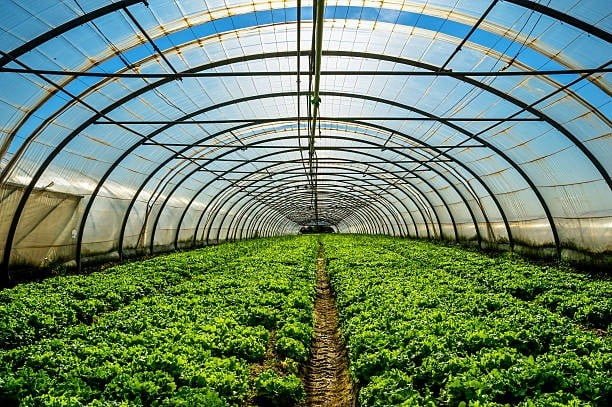This blog will tell you about Natural Green House. We will first explore the definition of Greenhouse in this blog. Then we will study the Description of Greenhouse. After the description, we will discuss the types of Greenhouses. Then we will discuss the Benefits of Greenhouse in detail. We will also learn the Disadvantages of Greenhouse. Then we will elaborate the Improvements of Greenhouse that can be made to make it Sustainable. This blog contains Description, Benefits, Disadvantages and Improvements for Greenhouses.
Introduction to Natural Greenhouse:
The concept of a natural greenhouse is not new, but its importance has grown exponentially in recent years due to the increasing need for sustainable living practices. A natural greenhouse, also known as nature friendly house, is a structure designed to grow plants in a controlled environment, using natural resources and processes to minimize its environmental impact. But there are many exceptional cases of using greenhouse to grow crops. It also have some major disadvantages such as less pollination, pest problems, and high investments. This is why it cannot be applied on larger scales because it needs a lot of money and concern with the whole process.
Description of Natural Greenhouse:
A natural greenhouse is typically made of transparent or translucent material like glass or plastic, which allows sunlight to enter and heat the interior. The heat is trapped inside, creating a warm and humid environment that is ideal for plant growth. The main purpose of natural greenhouse is to keep all natural resources in use and avoid extra costs for nutrients and other suitable things for crops and plants.
Unlike conventional greenhouses, natural greenhouses incorporate sustainable features such as rainwater harvesting systems, composting facilities, and solar panels. The structure is often designed to maximize natural ventilation, reducing the need for electric fans. Some natural greenhouses even include aquaponic systems, where fish and plants are grown together in a symbiotic relationship.
Types of Green Houses:
Following are the main types of Greenhouse:
Glass Greenhouse:
This is the oldest and traditional greenhouse among all types of Greenhouses. The walls of these greenhouse are made up of glass, plastic or fiberglass. Only glass greenhouse was used prior to 1950. This is a traditional greenhouse and are most preferred by gardeners.
Aquaponic Greenhouse:
This greenhouse combines hydroponics and aquaculture. In simple words, it grows plants in water and raise fishes in that water. It provide double advantage as it also provide good quality plants as well as good quality fishes at the same location and same system.
Gothic Arch Greenhouse:
Gothic arch greenhouse contain arched roof and walls, containing a continuous shape. This allows maximum sunlight to enter into the greenhouse that approved better growth of the plants. This greenhouse is widely known to withstand with severe winds and snowfall.
Aluminium Greenhouse:
Aluminium greenhouse contains clear polycarbonate walls and translucent polycarbonate roof. It also allows maximum sunlight to enter into the greenhouse. It is best for growing border crops. 100% of UV radiations enters into the greenhouse to provide nutrition to plants.
Dome Greenhouse:
These are dome-shaped greenhouses. Because of their shape, they help to shed water very easily and snow easily. Its shape also reduces the structural stress. Light in this greenhouse is uniformly distributed in the whole greenhouse. It is known for better strength and energy efficiency among all greenhouses.
Even Span Greenhouse:
You can distinguish these kinds of nurseries in the squint of two unmistakable slanting rooftops. The regular style and standard size structure is the even-range, the two rooftop inclines are of equivalent pitch and width. While building a nursery on slanted land, a lopsided range is much of the time the most productive plan.
These are few types of Greenhouses.

Natural Green House
Benefits of Natural Greenhouse:
Natural Greenhouse proves itself as a very effective and beneficial natural process. The benefits of a natural greenhouse extend beyond the obvious advantage of year-round plant cultivation. Here are some key benefits:
Sustainability:
By utilizing natural resources and processes, natural greenhouses significantly reduce their environmental footprint. Environmental footprint is the basic trigger of all environmental issues so we should switch towards sustainability by using natural greenhouse.
Cost-Efficiency:
Although the initial setup cost may be higher, the long-term savings from reduced energy and water usage make natural greenhouses a cost-effective solution. This will be a long-term solution which requires patience and a huge investment but it will be beneficial for future.
Healthier Produce:
Plants grown in a natural greenhouse are often healthier and more nutritious because they are grown in a more natural and less artificial environment. This is why natural greenhouse is proved more beneficial and effective than artificial greenhouse.
Minimize External Threats to Crops:
Greenhouse is effective because it is a closed system to some extent. The crops growing without greenhouse, face threats of invasive species or environmental hazards that are harmful for plants such as storms. Greenhouse minimizes or eliminates external threats for the plants in an effective way.
Extends Growing Season:
Greenhouse helps in maintaining the suitable temperature for the crops or plants to increase their life-span. In this way crops or plants can survive for a longer season and their suitable environment remain unchanged for a longer period of time and conditions remain favorable for them.
These were the benefits of greenhouses.
Disadvantages of Greenhouse:
As we have discussed that green house is an effective way to grow healthy and good quality plants, on the other hand it has few disadvantages that tells us it can be dangerous in some ways. Following are few disadvantages of Greenhouse:
High Upfront and Operating Expenses:
The biggest disadvantage or the reason everyone cannot use it, is that its operating cost and upfront is high. Operating cost means the amount that is needed to operate the whole system to keep it constant. While upfront is the advance investment that is done to set up the system. Both of these amounts are way too expensive as compared to traditional planting and farming. That is why, everyone cannot afford to built a greenhouse and produce crop through this method.
Pests and Less Pollination:
Greenhouse also creates possibilities to hold for pests in its hot and humid environment. Pests are attracted towards its environment and can lead to the damage of the crops and plants in the greenhouse. It provide suitable habitats for pests. Pest control is must in case of greenhouse to save the crops. Pollination is the natural process that involves transfer of pollen grains from one plant to another. In greenhouse, the insects are less due to less contact with natural environment so the process of pollination is restricted within a certain limit. That is why nourishment through pollination is limited in this environment.
These are the two major disadvantages of greenhouse.
Improvements for a Sustainable Environment:
To further enhance the sustainability of a natural greenhouse, several improvements can be implemented:
Energy Efficiency:
Incorporating energy-efficient technologies, such as LED lighting and solar-powered systems, can significantly reduce the greenhouse’s energy consumption. Energy efficient technologies will make it easier to practice sustainability as compared to conventional electronics.
Water Conservation:
Implementing advanced irrigation systems, like drip irrigation or self-watering planters, can help conserve water. Sprinkler irrigation and more options like this will be proved beneficial for the conservation of water in place of canal system and tube-well system.
Waste Management:
Composting organic waste within the greenhouse can provide nutrient-rich soil for the plants, reducing the needs for synthetic fertilizers. This will increase the efficiency of the soil without any synthetic fertilizers and other chemicals used for proper growth of crops.
Conclusion:
In conclusion, natural greenhouses represent a viable solution for sustainable agriculture. They offer a way to grow food year-round, using natural resources efficiently, and minimizing environmental impact. As we move towards a more sustainable future, the role of natural greenhouses will undoubtedly become increasingly important. But unfortunately it cannot be applied by everyone because of its high operating cost, high upfront and pest related hazards. It is a suitable system to conserve crops for a long time or to grow quality food to fight with food insecurity. But it needs many precautions to avoid hazards and protecting the crops and plants inside a greenhouse.

To learn about more topics, Click the links below:


Comments